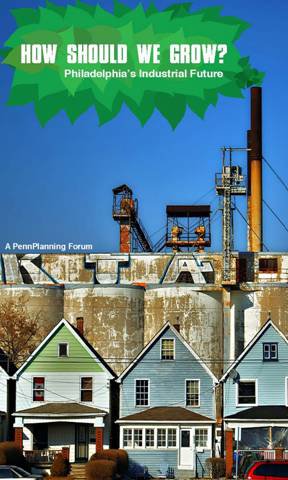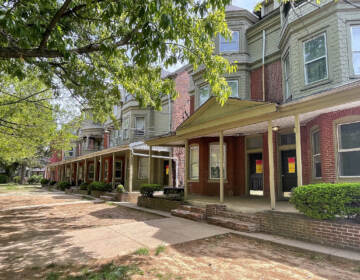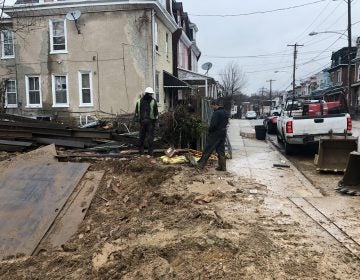Panel asks, ‘How should we grow?’

April 23, 2010
By Thomas J. Walsh
For PlanPhilly
The loss of industrial jobs and a decline in manufacturing in Philadelphia is certainly nothing new, but most residents of the region would probably trace the start of the downturn to the 1960s and ’70s. In fact, the attrition started in the 1920s, said Acting Deputy Mayor Alan Greenberger, at a panel Friday morning at the University of Pennsylvania’s School of Design.
Greenberger, still playing at least three roles as head of the Planning and Zoning Code commissions, said the decline abated during World War II, but resumed not long after.
“That big sea change has resulted in, depending on your point of view, either an opportunity or a problem that we need to solve,” he said. “We need to solve it at a time when we are embarking on the first comprehensive plan for the city in 50 years. For us, the Planning Commission, this industrial study is incredibly important.”
Greenberger was referring to the city’s soon-to-be-released “Industrial Market & Land Use Strategy,” researched and authored by the Philadelphia Industrial Development Corp. and a team of consultants.
On hand from PIDC to give an outline of the study was John Grady, vice president of real estate, and Prema Gupta, the quasi-public agency’s real estate manager.
“Prema told me not to say ‘post-industrial city’,” Greenberger said. “And she’s right. It’s a ‘post-19th and 20th century industrial city.’ That’s a fair statement. Things continue to be made here, as we broaden our understanding of what industry means.”
“Two-thirds of my R8 train ride to get to Center City is fallow, industrial land” of Civil War era vintage, said Gupta. “But there’s a mismatch between that and what modern users want.”
That’s an understatement, her remarks that followed revealed, underlining just how embedded industry is in what used to be called “The Workshop of the World.” As it happens, many of the long-abandoned buildings (and even some still in use) on all that land are multi-floor structures that pre-dated Ford-style assembly line manufacturing, which came into common use about a century ago.
Also presenting was Scott Page, founder and principal of Interface Studio, a main consultant to PIDC for the study. (PlanPhilly got a preview of the report, due out soon, last week at the American Planning Association conference in New Orleans, where Page was also a panelist. Read his extensive comments from that presentation here.)
“There is a market potential in Philadelphia, but to meet that potential, we need land to support it,” Page said Friday, referring to the city’s on-going rezoning process.
The special guest was Greg Nickels, the former mayor of Seattle (2002 through 2010), who had undertaken a similar study during his administration.
“I congratulate you on doing this,” Nickels said. “I’m very pleased that you’re asking the right questions, going through a very similar process that we went through where we asked our Planning Commission, ‘Just what is our future that you see?’ We brought in developers landowners and asked those questions, and at the end of the day we had a strategy that worked for us.”
Commentators at the end of the morning were John Landis, chair of City and Regional Planning at PennDesign; Brian Cohen of Liberty Property Trust (the company that is redeveloping the Navy Yard with PIDC); Ned Rauch-Mannino of the Urban Industry Initiative; Matt Pappajohn, a custom woodworker with a small company in the city’s Frankford section; and Paul Parkhill, a director at the Greenpoint Manufacturing and Design Center in Brooklyn. Moderating the event was Laura Wolf-Powers, assistant professor of city and regional planning at Penn.
“Thinking about how to grow – that’s not something we’re used to doing,” said Steve Wray, executive director of the Economy League of Greater Philadelphia.
Wray started the morning by stressing the importance of a fresh, innovative approach to business and economic development, and a description of Economy League efforts at “alternative histories of the future” to make for a “world-class Greater Philadelphia.”
The Economy League in recent years has worked with PIDC on a study of Philadelphia’s ports and their potential, and tackled subjects as broad as “green infrastructure,” the “knowledge industry” of our colleges and universities and the city’s state of entrepreneurship.
Contact the reporter at thomaswalsh1@gmail.com
(NOTE: Our apologies for the weak audio with the above videos – the participants did not use microphones, and the Flip camera’s acoustic capability is evidently in proportion to its size. – TJW)
WHYY is your source for fact-based, in-depth journalism and information. As a nonprofit organization, we rely on financial support from readers like you. Please give today.





